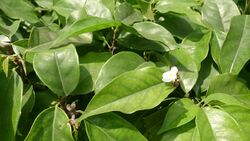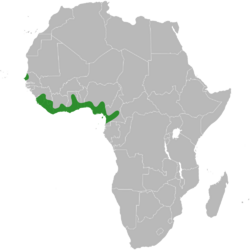Biology:Baphia nitida
| Baphia nitida | |
|---|---|

| |
| Scientific classification | |
| Kingdom: | Plantae |
| Clade: | Tracheophytes |
| Clade: | Angiosperms |
| Clade: | Eudicots |
| Clade: | Rosids |
| Order: | Fabales |
| Family: | Fabaceae |
| Subfamily: | Faboideae |
| Genus: | Baphia |
| Species: | B. nitida
|
| Binomial name | |
| Baphia nitida Lodd.
| |

| |
| The distribution of Baphia nitida. | |
| Synonyms[1] | |
| |
Baphia nitida, also known as camwood, barwood, and African sandalwood (although not a true sandalwood), is a shrubby, leguminous, hard-wooded tree from central west Africa. It is a small understorey, evergreen tree, often planted in villages, and known as osun in Yoruba.
The wood is of a very fine colour, and is used in woodturning for making knife handles and similar articles. The tree's bark and heartwood are commonly used to make a brilliant but non-permanent red dye, which is soluble in alkali.
Pterocarpin is a pterocarpan found in B. nitida.[2]
Osun (camwood) extract is also used in some soaps and skin treatments, primarily among the Yoruba people of West Africa. The extract of the Camwood can be formed into a soft soap like material that is thought to promote healthy skin.
References
- ↑ Soladoye MO (1985). "A revision of Baphia (Leguminosae-Papilionoideae)". Kew Bulletin 40 (2): 291–386. doi:10.2307/4108263.
- ↑ "Pterocarpin at knapsack_jsp". http://kanaya.naist.jp/knapsack_jsp/information.jsp?mode=r&word=C00009616&key=5.
External links
Wikidata ☰ Q5028820 entry
 |


